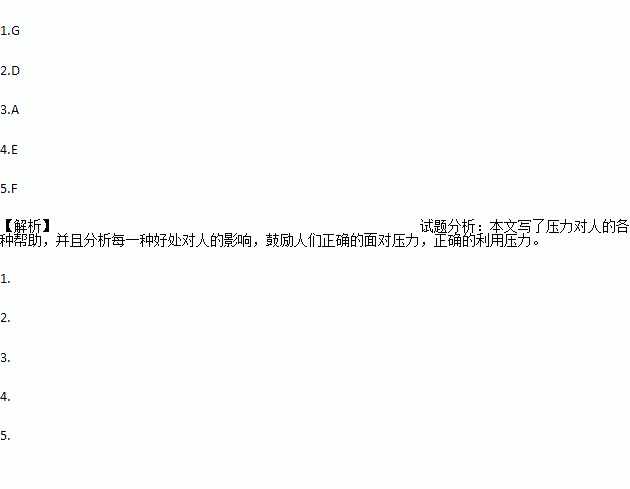题目内容
We all face quantities of stresses in day-to-day living, whether at work, in the home, or anywhere in between. 1. Here's how stress can help us on an everyday basis.
◆ Sharpen your memory.
Did you ever notice that sometimes when you are stressed, your memory seems to improve? Remember that test you passed where the answers seemed to come out of nowhere? 2. It's because of stress hormones(荷尔蒙)that increase your alertness(机敏) when it's most needed.
◆ 3.
Successful employees turn stress into motivation. Have you ever noticed that you get the least amount of work done when you have the fewest deadlines? Too little stress can affect how much you actually get done. When you take risks and choose to get over the difficulty, it improves your mental toughness and self-confidence.
◆ Helping you resist the attack of illness.
4. Believe it or not, the right kind of stress can help your body's defenses against illness. When you get sick, stress causes you to make hormones that battle threats to your health. That burst of stress is helpful to your immune system when your body faces a threat.
◆ Making your life more interesting.
Think about some stressful situations that we consciously put ourselves into make life more interesting and enjoyable, like asking someone out on a first date, conquering a known fear, or learning something new. These may not immediately come to mind when you think of stress because of the positive outcomes. 5.
A. Helping you get an advantage at work.
B. Helping you get through difficult times.
C. This will happen whenever you are stressed.
D. That's one way your brain responds to stress.
E. You need a healthy immune system to help fight off diseases.
F. But they're the types that can help you achieve fulfillment and happiness.
G.But handled properly,stress can have many benefits for the body and mind.
 阅读快车系列答案
阅读快车系列答案
